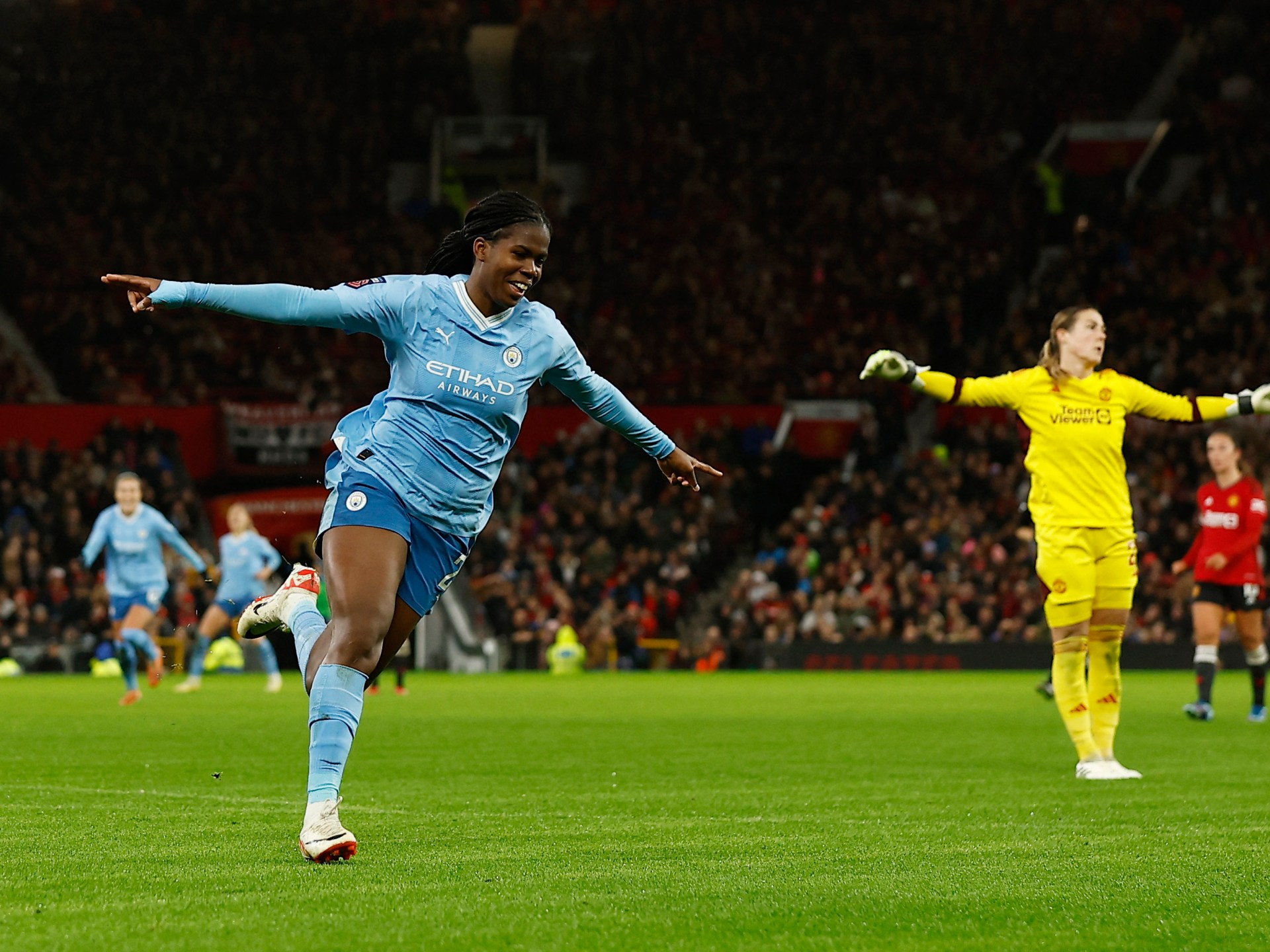Women’s football set to enter lucrative ‘NewCo’ era but pitfalls remain | Football News
The Women’s Super League and Women’s Championship’s decision to break free from the English Football Association and run independently from the next season will give the women’s game a newfound autonomy and play a vital role in shaping its future, experts say, although many pitfalls and uncertainties remain.
Last week, clubs from the top two tiers of women’s football in England announced they had unanimously agreed to form a new organisation (NewCo) to lead the women’s professional game from the 2024/25 season.
The English FA has run the Women’s Super League since its formation in 2010, with the addition of the second-tier Championship in 2014. However, in July 2022, the FA announced a desire for those leagues to change from being solely owned by the FA to being an independent entity.
NewCo, a working title at this stage, will function as an independent body with all 24 clubs from the Women’s Super League and Championship acting as shareholders. The organisation will be led by CEO Nikki Doucet, a former investment banker and Nike executive.
Kelly Simmons, former FA director of the women’s game, said the formation of NewCo will provide the women’s leagues a “laser focus”.
“The FA wasn’t the right long-term fit because it’s the governing body and regulator, and there are some commercial conflicts in that,” Simmons told Al Jazeera.
“We were concerned that if the women’s leagues just rolled into the men’s Premier League, it would not have sort of the laser focus or an independent voice, and might not be the highest priority.
“So we [at the FA] all agreed unanimously that the best model would be to set up a new company that has a laser focus, a board and an executive that is solely focused on making the best decisions for the women’s professional game.”
Simmons, who played a key role in developing the women’s game in England for three decades, believes that NewCo will enable the women’s game to have its own distinct voice, free from the men’s game.
“[The women’s game] has always been wrapped up in sort of the politics of whatever is going on in the men’s game and hasn’t been able to have that voice to call out what’s needed for the women’s game publicly and sometimes put pressure on the stakeholders,” added Simmons, who is now a sports consultant.
“So I think it’s good that, now it’s away from the FA, it’s got its own voice.”
However, some experts voiced concerns that the new structure could replicate some of the problems marring the men’s game and a lot remains unclear.
‘Right time’
Women’s football has seen a rapid rise in England, accelerated by the team’s success at the Women’s European Championship on home soil in 2022.
NewCo’s formation comes just over three months after England played in the Women’s World Cup final in Australia.
Alex Culvin, head of women’s football strategy and research at FIFPRO, said the leagues’ decision to function independently has come at the right time.
“The FA in England have probably taken the women’s game as far as they could go. And so I think, the time was was right in terms of the marketability of the game,” Culvin said. “The commercial value of the game is increasing … The women’s game in England has never been more appealing.”
Culvin, a former professional footballer who played for Everton, Leeds United and Liverpool, said an independent working structure is more beneficial for the growth of professional women’s leagues in general.
“For many women’s professional leagues across the world, the country’s football federations manage the development of the league. And what you find is that there’s a consolidation of power,” Culvin explained.
“So they manage the league and the international team. And that’s why consolidation of power can sometimes stunt the growth potential of women’s football because how do you strategically prioritise one over the other?”
Culvin highlighted the importance of independent governance by citing the National Women’s Soccer League (NWSL), the top-tier women’s league in the United States that is owned by the clubs.
NWSL is among the top leagues in global women’s football and almost all US national team players ply their trade there. The league is also commercially lucrative – according to data by Sportico, NWSL teams will collectively generate $112m in revenue during the 2023 regular season. The WSL generated revenues of 32 million pounds ($40.2m) in 2021-22.
“If you look at the NWSL … it has the opportunity to grow year on year. I think, in England, having the independence and the ability to strategically prioritise the growth of the women’s league is something that hasn’t been done before. It’s important and I’m incredibly excited,” Culvin said.
The WSL now believes it can become the first billion-pound ($1.24bn) women’s football league in the world within a decade.
The establishment of NewCo, similar to the Premier League’s governance model, is anticipated to contribute to the rapid and sustainable growth of women’s football, according to freelance journalist Nancy Gillen.
“While the FA obviously wanted women’s football to grow, it is hard for the organisation to be fully dedicated to this when they also have other commitments,” Gillen said.
“It is similar to when the Premier League broke away from the Football League and FA in 1991-92, giving it commercial independence. The Premier League is now one of the most successful and profitable sports leagues in the world, so that’s where the Women’s Super League and Championship could potentially be heading.”
Simmons said the formation of a new company to run the leagues independently will also benefit women’s football in England.
“A very successful Women’s Super League helps the England team and I think one of the reasons why England has been so successful has been because the players are training and playing every day with some of the best players in the world,” she said.
“On the other hand, a strong Championship will help England because a lot of young English talent needs to get meaningful minutes in game time in competitive games maybe when they’re too young to break into the Women’s Super League.”
Revenue structure
The new company has not revealed details on the structure of its governance, but the Athletic reported the Women’s Super League clubs will receive 75 per cent of the combined revenues from the two divisions and have all the voting power on commercial and broadcast matters.
Culvin raised concerns about the power grab by the top clubs.
“For me, it is quite problematic, because, again, there’s a consolidation of power among the bigger clubs,” Culvin added. “For this new foundation, I think it’s important that there’s no vested interest in providing an undemocratic decision-making amongst clubs.”
Simmons advocated for revenue sharing with lower division leagues in the future.
“At some point, when those revenues grow, there will need to be another conversation about whether money should go further down the pyramid to the Women’s National League and the tiers below, just like it does in the men’s game,” she said.
The Athletic also reported that 11 out of 12 Championship clubs had rejected an initial agreement over voting power on certain matters regarding how NewCo will function. But after receiving an ultimatum from the Women’s Super League clubs, the Championship clubs voted unanimously in favour of the deal.
Gillen, a women’s football expert, said there is a risk of more disputes between the two divisions.
“I would really hope that all decisions would be made to benefit both leagues, but there is always the chance of the gap between the Women’s Super League and Championship getting bigger,” she said.
Meanwhile, no financial fair play rules have been announced for the leagues.
As the women’s leagues break away from the governing body, Simmons also stressed the importance of the FA maintaining a relationship with the women’s game.
“The FA will need to think through how they manage and develop the relationship with the new company to make sure that there’s a joined-up strategy, particularly across things like youth talent, talent development, and club development,” she explained.
NewCo’s to-do list
Simmons said NewCo’s first major task would be to secure a new broadcast deal for the Women’s Super League, with the FA’s multimillion-pound deal with Sky Sports and the BBC set to end next season.
Culvin suggested that NewCo should focus on establishing new licensing criteria for clubs and also emphasised the need for a review of the remuneration of players to avoid a huge wage gap between the clubs.
The former defender added that the new company should also take into consideration the recommendations put forth by Karen Carney to help improve the standards of women’s football in England.
Former player-turned-pundit Carney undertook an independent review into women’s football in England last year and published the findings in July, outlining recommendations aimed at leveraging the success of the England women’s team and establishing a pathway towards a successful and sustainable commercial future for domestic women’s football.
The British government has endorsed the recommendations and pledged its support to the FA and NewCo in the full professionalisation of the women’s game.
“While I’m encouraged by this kind of innovative sort of new governance structure of the Women’s Super League and Championship, I think there’s not a lot of information around actually how it will operate in practice,” Culvin said.
Check out our Latest News and Follow us at Facebook
Original Source







